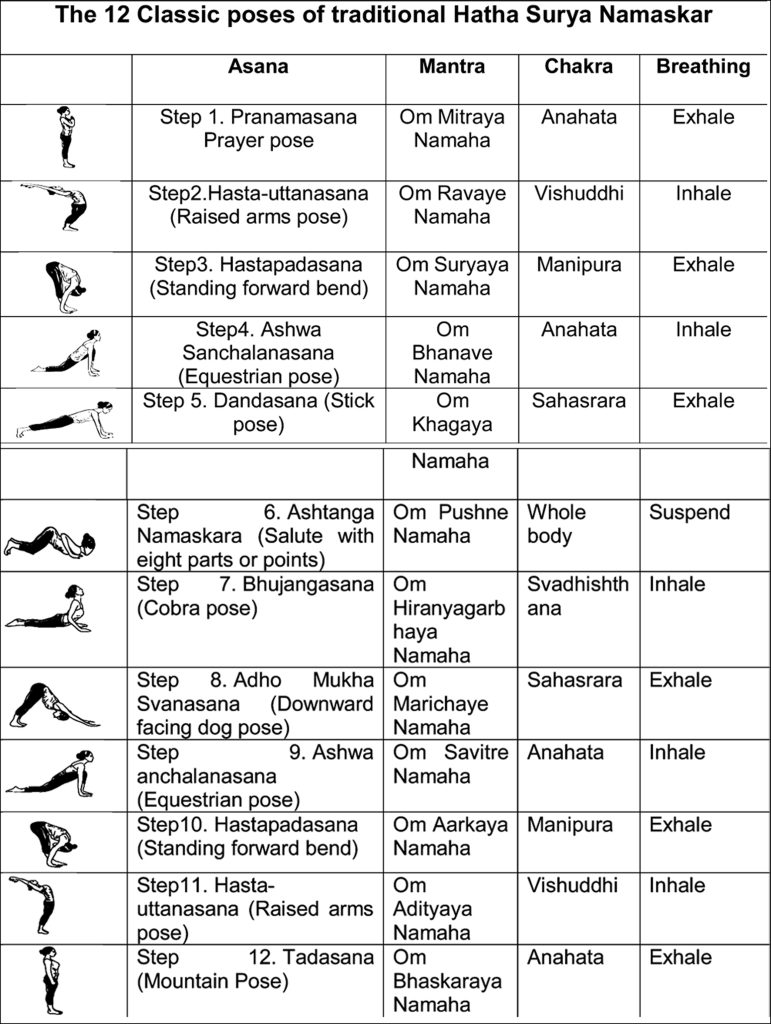Surya Namaskar (Sun Salutation)
Dr Neena Sharma
SuryaNamaskar, also known as sun salutation, is a graceful series of twelve yoga poses that is traditionally done to salute the Sun as a sign of respect and gratitude. The custom is believed to have originated from an early morning sun worship ritual. It is intended to harmonise the functions of the body, mind, and breath.
Mythology related to Surya Namaskar
In the history of the sun salutation,Hindus revere “Surya” as their god and view it as the source of all life. The ramayana occurrence in which Hanuman swallowed the sun as a child, serves as the basis for the mythological story of the suryanamaskar. The sun educated Hanuman sacred hinduscriptures, vedasand shastras while Hanuman paid guru dakshina by regularly practising suryanamaskar. This underlines the origin of Suryanamaskar.
History of Surya Namaskar
The suryanamaskar did not always look the way it does now. The Surya Narayana pujas are a group of rites that are suggested as the source of the suryanamaskar. Its origin dates back to 2,500 years. Surya Namaskar is now a complete set of 12 sequential positions after undergoing numerous alterations and adaptations over time.
It is thought that suryanamaskar originated during the vedic era and has been transmitted through vedic sages over many centuries. The Sanskrit words “Surya” and “Namaskar,” which translate to “sun” and “greeting,” respectively, are where the term suryanamaskar originates. The original suryanamaskar was a collection of sacred words chanted before dawn, not a sequence of yoga positions.
One of the first figures connected to the practise of the sun salutation is the saint Samarth Ramdas, who lived in the 17th century. He developed this technique without sequencing the correct motions. BhawanraoShriniwasrao Pant Pratinidhi, the ruler of Aundh (current-day Pune, India), gave this sequence the name Surya Namaskar.Notable figures such as T. Krishnamacharya, his students, K. Pattabhi Jois, the father of Ashtanga Vinyasa, and B.K.S. Iyenger, the founder of Iyenger yoga, all learned suryanamaskar and advanced it into their respective yoga schools.

Types of Surya Namaskar
Daily Surya Namaskar practise assists in balancing our body’s three primary energy, Pitta (body heat), Vata (air), and Kapha (phlegm), which influences our creativity and intuition. People of all ages can perform it anytime, anywhere.Numerous kinds of yoga incorporate Surya Namaskar.
- Ashtanga Surya Namaskar: There are two types of Sun Salutations in the Ashtanga Surya Namaskar series: Type A and Type B. There are nine vinyasas in type A and seventeen in type B.
- Hatha Surya Namaskar: It is a sequence of twelve spinal poses with emphasis on breathing. It is the earliest most common Surya Namaskar styles.
- Iyengar Surya Namaskar: It is similar to hatha suryanamaskarbut performed at a quicker pace.
The Sun symbolises light, purity, clarity and consciousness.The regular practice of Surya Namaskar imparts power and radiance of sun because of which it is known as “Salute to Sun”.It is performed with corresponding suryanamaskar mantrawith special concentration on each chakra or focal points ofbody.
The seven energy wheels in the body known as Chakras, run from the top of the head to the base of the spine. The body’s energy centre is the third chakra, also known as Manipura, Solar Plexus, or Navel. A network of radiating nerves in the pit of the stomach called the solar plexus chakra is thought to be connected to the sun. The solar plexus grows in size with regular suryanamaskar practise, which enhances leadership, intuition, creativity, and confidence.Conditions such as indigestion, impaired skilful self-expression, aggression, lack of confidence, and low self-esteem can arise when the solar plexus chakra is out of harmony.
Performing suryanamaskar with mantra chants and awareness on chakras adds a feel of gratitude, spirituality and meditative aspect.
The overall benefits of Suryanamaskar are- - Balance of Dosha: The three doshas-Pita, Kapha, and Vata,can be kept in line by dailypractice of suryanamaskar.
- Weight-loss Booster: Stretching the abdominal muscles burns the calories & manages the thyroid gland secretions.
- Improves mental health: It strengthens the focus, relaxes mind, reduces sleepiness, somatic stress, worry, and negative emotions.
- Skin and Complexion: Regular practice improves blood circulation, brings glow to the face and improves elasticity of the skin.
- Digestive System: Routine practice increases the blood flow to the intestine and enhances intestinal peristalsis.
- Menstrual Cycle: Regular practice helps in regularcycles, relief from cramps during periods and also aids in natural child birth.
- Detoxification: Due to active breathing, lung capacity increases, lungs are ventilated and the blood gets oxygenated. Also, it improves the lymph flow, which removes the toxins from the body.
- Miscellaneous: Reduces blood sugar levels, relieves frozen shoulder and revitalises the entire body.
A boon for all age groups, suryanamaskar is an intensive exercise and regular practice of it maintains good health.
(The writer is Associate Professor, Department of Physiology, AIIMS Jammu)
